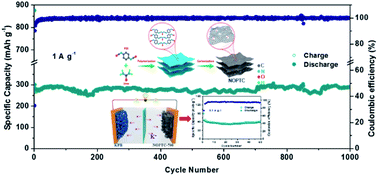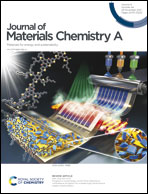Two-dimensional N/O co-doped porous turbostratic carbon nanomeshes with expanded interlayer spacing as host material for potassium/lithium half/full batteries†
Abstract
The development of carbon nanomaterials, which have the merits of being based on an abundant resource and environmentally friendly, as stabilized rechargeable ion battery anodes faces enormous challenges due to the limited interlayer spacing and sluggish kinetics. Herein, we synthesized high-yield two-dimensional N/O co-doped porous turbostratic carbon nanomeshes (NOPTCs) with an ultralarge interlayer spacing (0.434 nm) and abundant edge defects via a combination copolymerization and carbonization strategy. Benefiting from its structural properties, the optimized NOPTC-700 achieves remarkable electrochemical performance as an anode material for both potassium-ion (292.8 mA h g−1 at 1 A g−1 after 1000 cycles and 219.0 mA h g−1 at 2 A g−1) and lithium-ion (466.7 mA h g−1 at 2 A g−1 after 2000 cycles) batteries. The underlying potassium-ion storage mechanism was clarified via detailed ex situ Raman analysis, which indicated a highly reversible ion insertion and extraction process. First-principles calculations further prove that the sufficient defects and reactive sites induced by heteroatom N/O co-doping contribute synergistically to the excellent electrochemical performance of the NOPTCs. The NOPTC-700 delivers outstanding full cell performance coupled with a potassium Prussian blue (KPB) cathode in potassium-ion batteries (PIBs) as well as with a commercial LiFePO4 (LFP) cathode in lithium-ion batteries (LIBs), exhibiting great potential and broad prospects in practical applications.



 Please wait while we load your content...
Please wait while we load your content...